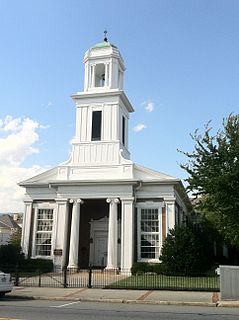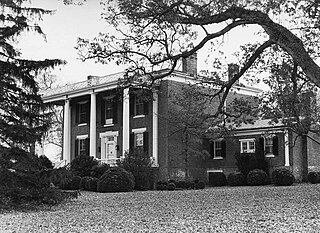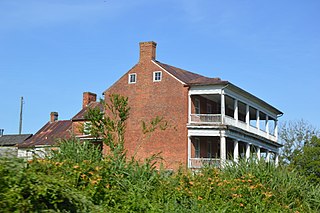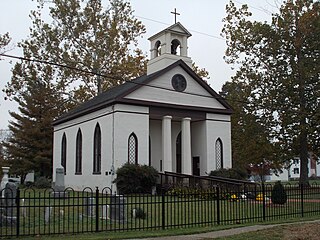
Roanoke City Market Historic District, also known as City Market District, is a national historic district located in the Downtown Roanoke area of Roanoke, Virginia.

The South River Friends Meetinghouse, or Quaker Meeting House, is a historic Friends meeting house located at Lynchburg, Virginia. It was completed in 1798. It is a rubble stone structure, approximately 30 by 51 feet, with walls 16 inches thick, and 12 feet high. The building ceased as a Quaker meeting house in the 1840s, and stands on the grounds of the Quaker Memorial Presbyterian Church. Adjacent to the structure is a historic graveyard. Buried there are Sarah Lynch and her son John, the founder of the city whose final resting place is marked by a plain Quaker stone and a modern plaque.

The Lexington Historic District is a national historic district located at Lexington, Virginia. It includes 11 contributing buildings on 600 acres (240 ha) and dates from 1823. It includes Greek Revival, Queen Anne, "Picturesque Cottage", and other architecture. Notable buildings include Washington Hall located on the campus of Washington and Lee University, the Virginia Military Institute, Court House, Presbyterian Manse, Halestones, and The Castle. Located in the district are the separately listed Alexander-Withrow House, Barracks, Virginia Military Institute, the Stonewall Jackson House, Lee Chapel, Lexington Presbyterian Church, Reid-White-Philbin House, and Stono.

Salem Presbyterian Church is a historic Presbyterian church at E. Main and Market Streets in Salem, Virginia. It was built in 1851–1852, and is a Greek Revival style temple form church. It has a slightly projecting Ionic order portico in antis with belfry. The church owned the Salem Presbyterian Parsonage from 1854 to 1941.

Onancock Historic District is a national historic district located at Onancock, Accomack County, Virginia. The district encompasses 267 contributing buildings, 2 contributing sites, and 2 contributing objects. It includes most of the historic residential, commercial, and ecclesiastical buildings in the town of Onancock. The buildings represent a variety of popular architectural styles including the Late Victorian, Greek Revival, and Federal styles. Notable buildings include Scott Hall, Alicia Hopkins House (1830), Harmon House, Holly House (1860), Ingleside (1880s), Dr. Lewis Harmanson House (1899), Harbor Breeze (1912), First National Bank, Roseland Theatre, Market Street Methodist Church (1882), Naomi Makemie Presbyterian Church (1895), the Charles E. Cassell designed Holy Trinity Episcopal Church (1882), Onancock Town Hall, Onancock High School (1921), and Onancock Post Office (1936). Located in the district and separately listed are the Cokesbury Church, Hopkins and Brother Store and Kerr Place.

Buchanan Historic District is a national historic district located at Buchanan, Botetourt County, Virginia. It encompasses 277 contributing buildings, 5 contributing sites, and 4 contributing structures in Buchanan and Pattonsburg on both sides of the James River. They include commercial, transportation-related, domestic, religious, and industrial resources associated with the community's development from the late-18th century through the late-20th century. Notable buildings include the Pattonsburg Mill (1838), Buchanan Presbyterian Church (1845), Trinity Episcopal Church (1842), Hotel Botetourt (1851), Sorrell House (1850), James Evans Mason Lodge (1884), Virginia Can Company complex (1903), "Oak Hill" (1840), Town Hall Municipal Building, Bank of Buchanan, Ransone's Drugstore, Buchanan Theatre (1919), and Buchanan High School (1928). The contributing sites include the James River & Kanawha Canal project site, Johnston-Boyd Cemetery (1835–1906), and Mountain View Cemetery (1854). The contributing structures include the Stone Arch Tunnel (1870s). Also located in the district is the separately listed Wilson Warehouse.

Wilson Warehouse is a historic combined dwelling, warehouse, and store building located at Buchanan, Botetourt County, Virginia. It was built in 1839, and is a two-story, six bay, brick building in the Greek Revival style. It measures 54 feet by 48 feet

Santillane is a historic home located near Fincastle, Botetourt County, Virginia. It was built in 1795, and consists of a two-story high, three bay by four bay, main block with a one-story, rear kitchen wing. It is constructed of brick and is in the Greek Revival style. The house has a shallow hipped roof and tetrastyle two-story front portico dated to the early 20th century. Also on the property is a contributing stone spring house. The house stands on a tract purchased by Colonel George Hancock (1754–1820) in 1795. The kitchen wing may date to his period of ownership.

Wiloma is a historic home near Fincastle, Botetourt County, Virginia. It was built in 1848, and is a two-story, brick I-house dwelling with Greek Revival style detailing. It has a two-level pedimented porch on the south and a long two-story wing with a two-level porch completed in 1888.

Wheatland Manor is a historic home located near Fincastle, Botetourt County, Virginia. Built circa 1820, it is a two-story, five bay, brick, center passage plan I-house dwelling with interior Federal style detailing. It has a two-level Greek Revival style porch and two-story brick ell dated to the 1850s. Attached to the ell is a one-story frame kitchen wing. Also on the property are a contributing retaining wall, site of a terraced garden, ruins of an ice house, and foundation.

Greenfield, also known as Col. William Preston Plantation, Preston House, and Botetourt Center at Greenfield, is a historic plantation site located at Fincastle, Botetourt County, Virginia. It is the site of a large forced-labor farm AKA enslaved people established in the mid-18th century by Colonel William Preston (1729-1783) before he moved to Smithfield in 1774. The plantation house was destroyed by fire in 1959. The remaining buildings are kitchen/quarters and saddlebag slave dwelling.

Port Royal Historic District is a national historic district located at Port Royal, Caroline County, Virginia. The district encompasses 35 contributing buildings in the historic core of the 18th century tobacco port of Port Royal. Notable buildings include the 18th-century Fox's Tavern, the mid-19th century Masonic Hall, the 18th-century frame mansion of the Brockenbrough family, the Hipkins-Carr House, the Gray House, and St. Peter's Episcopal Church. Townfield and Riverview are separately listed.

Delaplane Historic District is a national historic district located at Delaplane, Fauquier County, Virginia.

Gloucester County Courthouse Square Historic District is a national historic district located at Gloucester Courthouse, Gloucester County, Virginia. The district encompasses 17 contributing buildings including the Gloucester County government buildings and those structures bordering the square, housing private businesses, offices and residences. The courthouse was built about 1766, and is a one-story, "T"-shaped brick structure with a hipped roof. Other notable buildings include the Botetourt Hotel ; the Botetourt Lodge; W. C. Tucker's Department Store Building; S and S Hobbies; and the Kearn's Real Estate storage house.

Madison County Courthouse Historic District is a national historic district located at Madison, Madison County, Virginia. The district encompasses 66 contributing buildings in the county seat of Madison. In addition to the separately listed Madison County Courthouse, there are a variety of residential, commercial, and institutional buildings dating from the early 19th to the 20th century. Notable buildings include the County Clerk's Office (1832), the Washington Tavern or Eagle House, the Arcade (1830s), Piedmont Episcopal Church (1832-1834), the Madison Presbyterian and Methodist churches (1852-1853), Hunton House Hotel, and the Linn Banks Masonic Lodge (1855).

Blacksburg Historic District is a national historic district located at Blacksburg, Montgomery County, Virginia. The district encompasses 137 contributing buildings and 2 contributing sites in the central business district and surrounding residential areas of the town of Blacksburg. The district includes commercial, residential, and institutional buildings in a variety of popular architectural styles including Greek Revival, Gothic Revival, and Colonial Revival. Notable buildings include the Johnson House, Blacksburg Presbyterian Church #1 (1847), Smith-Montgomery House, Croy House, Spout Spring House, Deyerle's Store (1875-1877), W. B. Conway Building, Presbyterian manse (1907), Sheriff Camper House, Christ Episcopal Church, African Methodist Episcopal Church of Blacksburg, Blacksburg Presbyterian Church (1904), Blacksburg Methodist Church (1910), St. Mary's Catholic Church, Hunter's Lodge Masonic Building (1928), Martin-Logan Store, Lyric Theater (1922), and Ellett's Drug Store (1900).

Blackstone Historic District is a national historic district located at Blackstone, Nottoway County, Virginia. It encompasses 272 contributing buildings and 1 contributing structure in the town of Blackstone. They include residential and commercial structures dating from the late-18th to early-20th centuries. They include notable examples of the Late Gothic Revival, Queen Anne, and Romanesque styles. Notable buildings include the former Blackstone College for Girls (1922), First National Bank, Thomas M. Dillard House, Richmond F. Dillard House, Blackstone Public School Complex, Bagley House (1911), James D. Crawley House (1903), Blackstone Baptist Church (1907), Crenshaw United Methodist Church (1903), St. Luke's Episcopal Church (1916), and Blackstone Presbyterian Church (1901). The James D. Crawley House was designed by J. E. McDaniel, who was a local architect. Located in the district is the separately listed Schwartz Tavern.

Gordonsville Historic District is a national historic district located at Gordonsville, Orange County, Virginia. It encompasses 85 contributing buildings and 2 contributing structures in the town of Gordonsville. They include 19th- and early 20th-century residential, commercial and institutional buildings in a variety of popular architectural styles including Colonial Revival, Greek Revival, and Georgian Revival styles. Notable buildings include the E.J. Faulconer House, Faulconer-Schlosser House (1868), Linney-Barbour Building (1870), Swan-Payne House (1901), Magnolia House, Gordonsville Christian Church, Gordonsville Presbyterian Church (1855), Gordonsville Methodist Church (1873), St. Mark's Catholic, Christ Episcopal Church, Grammar School (1877-1878), Memorial Hall, Sneed's Store, Allman Building, Gordonsville Motor Car Company Building, The Old Oaken Bucket, and the Blakey Building (1916). Located in the district is the separately listed Exchange Hotel.

St. John's Episcopal Church is a historic Episcopal church in Roanoke, Virginia, United States. It was built in 1891–1892, and is a Gothic style blue-gray limestone church designed by Charles M. Burns of Philadelphia. It has a nave-plan with side aisles, a corner bell tower, a sacristy wing, and a transverse chapel and narthex to the rear. The nave features a hammerbeam roof and wooden arcading and is illuminated by stained glass windows in the clerestory and side aisle walls including several by Louis Comfort Tiffany. Attached to the church by a stone addition built in 1958, is a Tudor Revival style Parish House built in 1923.

The Winchester Historic District is a national historic district located at Winchester, Virginia. The district encompasses 1,116 contributing buildings in Winchester. The buildings represent a variety of popular architectural styles including Late Victorian and Italianate. They include residential, commercial, governmental, industrial, and institutional buildings dating from the 18th to mid-20th centuries. Notable buildings include the A.M.E Church (1878), Masonic Lodge and Gray and Eddy Building, First Presbyterian Church, Farmers and Merchants Bank (1902), Frederick County Courthouse (1840), Grace Lutheran Church, Friendship Fire Hall (1892), John Kerr School, City Hall (1900), Lewis Jones Knitting Mill (1895), Tidball Residence, William F. Hottle Residence, McGuire Residence, and Robert Long House. Located in the district are the separately listed Thomas J. Jackson Headquarters, Fair Mount, Handley Library, Adam Kurtz House, and Daniel Morgan House.
























